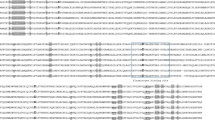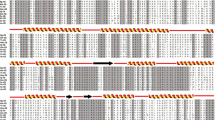Abstract
Sporozoites and merozoites of three species ofEimeria, E. tenella, E. maxima, andE. necatrix, that cause diarrhea in chickens worldwide, were examined for their expression of sialidase (SA) activity. The enzyme was found in three species, and the activity of merozoites was 10–20 times higher than that of sporozoites. The enzyme was resistant to degradation by proteases that are normally present in the intestine, a site inhabited by theEimeria parasites, and it was relatively resistant to heat, with optimum activity being at 40°C, which is within the range of temperature in the chicken intestine (40–43°C).E. tenella SA was immuniprecipitated by monoclonal and polyclonal antibodies raised against theTrypanosoma cruzi SA (TCSA), and enzyme activity was neutralized by these antibodies.E. tenella SA was identified by immunoblots as a doublet of molecular weight 190 000 and 180 000 using, as a probe, anti-TCSA antibodies and antibodies against a synthetic peptide (TR) derived from the long tandem repeat domain of TCSA. Binding of the monoclonal and polyclonal antibodies toE. tenella was completely blocked by TR, but not by an irrelevant peptide (BR). Therefore,E. tenella expresses a developmentally regulated SA that is structurally related to theT. cruzi counterpart. Because of the high SA activity in merozoites, and by analogy with other SA-producing microbes that inhabit mucin-rich epithelia, we suggest that theEimeria SA plays a role in desialylating intestinal mucins to reduce viscosity of the local environment and thereby facilitate parasite migration. The enzyme could also play a role in host cell-parasite interaction.
Similar content being viewed by others
Abbreviations
- SA:
-
sialidase (neuraminidase)
- Neu5Ac:
-
N-acetylneuraminic acid
- 4-MU-Neu5Ac:
-
2′-(4-methylumbelliferyl)-α-N-acetyl-d-neuraminic acid
- BSA:
-
bovine serum albumin
- PBS:
-
phosphate buffered saline
- PMSF:
-
phenylmethylsulfonyl fluoride
- PNA:
-
peanut agglutinin
- Ab:
-
antibody
- TCN-2:
-
monoclonal antibody toT. cruzi sialidase, anti-Ars, monoclonal antibody top-azophenylarsonate
- TCSA:
-
Trypanosoma cruzi sialidase
References
Ball SJ, Pittilo RM, Long PL (1989)Adv Parasitol 28:1–54.
Reid MW, Long PL, McDougal LR (1984) InDisease of Poultry. Iowa: Iowa State University Press.
Colman PM, Ward CW (1985)Curr Topics Microbiol Immunol 114:177–255.
Pereira MEA (1990) InModern Parasite Biology: Cellular, Immunological and Molecular Aspects, (Wyler D, ed), pp. 64–78. New York: W. H. Freeman.
Pereira, MEA (1983)Science 219:1444–46.
Strout RG, Ouellette CA (1970)Am J Vet Res 31:911–18.
Pereira MEA (1983)J Immunol Methods 63:25–34.
Potier M, Mameli L, Belisle M, Dallaire L, Melancon SB (1979)Anal Biochem 94:287–96.
Pereira MEA, Mejia JS, Ortega-Barria E, Matzilevich D, Prioli RP (1991)J Exp Med. 174:179–91.
Sambrook J, Fritsch EV, Maniatis T (1989)Molecular Cloning: A Laboratory Manual. Cold Spring Harbor: Cold Spring Harbor Laboratory.
Prioli RP, Mejia JS, Pereira MEA (1990)J Immunol 144:4384–91.
Siekevitz M, Gefter, ML, Brodeur P, Riblet R, Marshak-Rothstein A (1982)Eur J Immunol 12:1023–32.
Prioli RP, Ortega-Barria E, Meija JS, Pereira MEA (1992)Mol. Biochem Parasitol 52:85–96.
Bradford M (1976)Anal Biochem 72:248–54.
Cavallesco R, Pereira MEA (1988)J Immunol 140:617–25.
Farooqui AA, Lujan B, Hanson WL (1983)Experientia 39:1368–70.
Anderson BE (1977) InDuke's Physiology of Domestic Animals (Swenson MJ, ed) pp 695–96. Ithaca, NY: Cornell University Press.
Pellegrin JLG, Ortega-Barria E, Prioli RP, Pereira MEA (1992)Trop Med Parasitol 43:33–37.
Faillard H, Schauer R (1972) InGlycoproteins, Their Composition, Structure and Function (Gottschalk A, ed), pp 1246–67. Amsterdam: Elsevier.
Gottschalk A, Thomas MAW (1961)Biochim. Biophys Acta 46:91–98.
Kilbourne ED (1975)The Influenza Virus and Influenza. New York: Academic Press.
Leprate R, Michel-Briand Y (1980)Ann Microbiol (Paris)131:209–22.
Scanlon KL, Diven WF, Glew RH (1989)Enzyme 41:143–50.
Pereira MEA (1988) InThe Biology of Parasitism (Englund PT, Sher A, eds), pp 105–9. New York: Alan Liss.
Ravdin JI, Stanley P, Murphy CF, Petri JW (1989)Infect Immun 57:2179–86.
Kornfeld R, Kornfeld S (1980) InThe Biochemistry of Glycoproteins and Proteoglycans (Lennarz WJ, ed), pp 1–34. New York: Plenum Press.
Augustine PC, Danforth HD (1984)J Protozool 31:140–44.
Author information
Authors and Affiliations
Rights and permissions
About this article
Cite this article
Pellegrin, JL.J., Ortega-Barria, E., Prioli, R.P. et al. Identification of a developmentally regulated sialidase inEimeria tenella that is immunologically related to theTrypanosoma cruzi enzyme. Glycoconjugate J 10, 57–63 (1993). https://doi.org/10.1007/BF00731188
Received:
Issue Date:
DOI: https://doi.org/10.1007/BF00731188




